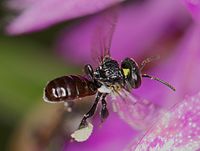
Photo from wikipedia
Marine comb jellies utilize cilia, arrays of bundled protein microtubules, for propulsion in water. Previous studies have reported on the orientation of the microtubules in steady electric and magnetic fields.… Click to show full abstract
Marine comb jellies utilize cilia, arrays of bundled protein microtubules, for propulsion in water. Previous studies have reported on the orientation of the microtubules in steady electric and magnetic fields. Here, the effects of pulsed magnetic fields up to 2.2 Tesla on cilia fragments was investigated by examining changes in light scattering. Specifically, a comb jelly was placed in electromagnetic coils and illuminated with 472-nm laser light. Light scattering by isolated intact cilia was collected with an optical fiber and ported to a spectrophotometer. After pulsed magnetic field exposure, light scattered parallel to the field oscillated or decreased, depending on the initial cilia alignment with respect to the angle of the incident light. Changes in scattering were also detected for cilia that had been fixed with formalin and had no neural activity. Real-time observations indicated that they were caused by bending of cilia under induced electric fields, suggesting an electromechanical actuator in the comb jelly.Marine comb jellies utilize cilia, arrays of bundled protein microtubules, for propulsion in water. Previous studies have reported on the orientation of the microtubules in steady electric and magnetic fields. Here, the effects of pulsed magnetic fields up to 2.2 Tesla on cilia fragments was investigated by examining changes in light scattering. Specifically, a comb jelly was placed in electromagnetic coils and illuminated with 472-nm laser light. Light scattering by isolated intact cilia was collected with an optical fiber and ported to a spectrophotometer. After pulsed magnetic field exposure, light scattered parallel to the field oscillated or decreased, depending on the initial cilia alignment with respect to the angle of the incident light. Changes in scattering were also detected for cilia that had been fixed with formalin and had no neural activity. Real-time observations indicated that they were caused by bending of cilia under induced electric fields, suggesting an electromechanical actuator in t...
Journal Title: AIP Advances
Year Published: 2019
Link to full text (if available)
Share on Social Media: Sign Up to like & get
recommendations!